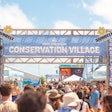In what was one of the more visually stimulating show seasons in recent years, New York Fashion Week saw designers utilize venues and technology to impress their guests and differentiate themselves. From the Row and Versus Versace to, most notably Opening Ceremony and Polo Ralph Lauren, brands continued to discover and utilize the most imaginative of venues—or, as was the case at Carolina Herrera, completely redefine the layout of their show. Held September 4 to 11 at locations all over the city, the shows presented plenty of incentive to skip the live streams and be physically present—if not for the clothes, then the sets themselves.
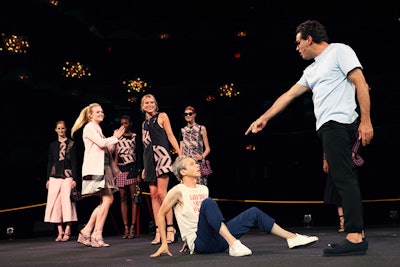
The setting was the star of Spike Jonze and Jonah Hill’s 100% Lost Cotton Fashion Week play that doubled as Opening Ceremony’s spring show on September 7. Held at the iconic Metropolitan Opera House, the location wasn’t immediately clear from the address on the invitation: 109 Amsterdam Avenue turned out to be a loading dock, which guests were ushered through before finding their seats behind the curtain. The rare perspective for guests, facing the venue’s plush red seats and famous chandeliers, allowed them to watch the cast, which consisted of the likes of Karlie Kloss, John Cameron Mitchell, Bobby Cannavale, Catherine Keener, Rashida Jones, and Elle Fanning.

Produced by Bureau Betak, the September 4 Altuzarra for Target launch party at Skylight Clarkson Square had guests enter a cavernous mirrored room filled with thousands of strung lights. The event's decor created a veritable twilight zone—including 1,140 strands of light and 1,420 feet of drape—with minimal seating areas, not to mention a lengthy walk to the shop-in-shop. Long mirrors broke up the main room into multiple smaller areas, which were filled with mannequins dressed in the new collection—combining a fun-house atmosphere with the layout of a walk-in closet. In keeping with the ad campaign starring 41-year-old Eva Herzigova, the 750-person event was a more subdued and grown-up affair, what with the dark space draped in black curtains and no live performance.
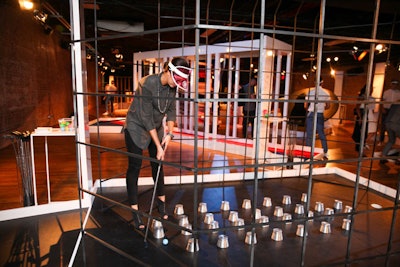
On September 4, Refinery29 hosted the opening of a three-day pop-up miniature nine-hole golf course—its first wholly owned Fashion Week event—inspired by nine New York designers like Diane von Furstenberg, Alexander Wang, Marc Jacobs, and Proenza Schouler. Produced by BMF Media with an intimate acoustic set by Banks, the interactive event at 82 Mercer in SoHo challenged guests to channel their inner Rory McIlroy—only with each hole sporting a fashionable twist.

Instead of a traditional windmill, Refinery29's pop-up country club included fashion-minded takes on course decor. There was, for example, a cage and floor full of studs at Alexander Wang and fabric wraps at Diane von Furstenberg. Caddies, meanwhile, wore all-white Topshop uniforms with R29-branded visors. Up front, there was also a Fashion Pros wall honoring 29 New York designers and a snack bar with refreshments, courtesy of Stumptown Coffee and Momofuku Milk Bar.

Gareth Pugh unveiled his Spring 2015 collection on September 4, transforming Pier 36 in Manhattan into a smoky, light-filled performance space for a Lexus-sponsored Design Disrupted live immersive fashion experience.
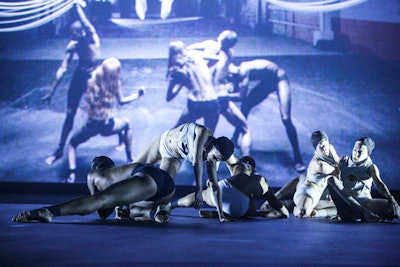
Produced by Legs Media, the multifaceted installation space featured a blend of music, dance, art, and fashion with live performances and videos—choreographed by Wayne McGregor—that included artists dancing in three installments placed at opposite ends of the vast space. The program also allowed a first live view of the all-new Lexus RC F performance coupe.

For his September 5 show at Spring Studios entitled “Beauty,” Jason Wu went simple and stark with the all-white venue. Produced by Bureau Betak, the space featured simple white bench seating and a floor-to-ceiling backdrop that mimicked a deconstructed boudoir mirror—with detached molding that created a mirage-like effect.
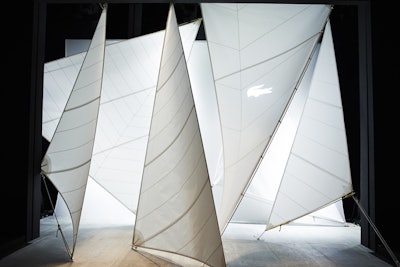
To complement the sail-worthy garments and sporty silhouettes shown on the runway, Bureau Betak erected a yacht-theme backdrop for the September 6 Lacoste show inside the Mercedes-Benz Fashion Week tents at Lincoln Center. Guests sat on concrete-like surfaces that also covered the runway, while the half dozen or so sails erected as the backdrop were firmly anchored to the floorboard.
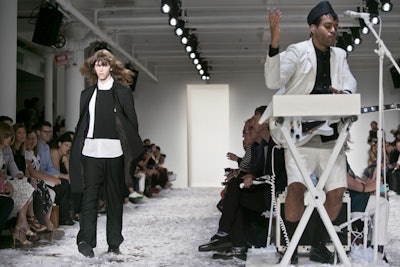
In lieu of a traditional fashion show, Public School designers Dao-Yi Chao and Maxwell Osborne enlisted Twin Shadow to perform live and architecture firm Snarkitecture to design a set for their September 7, KCD-produced show. Approximately 200 pounds of white confetti was arranged in the Milk Studios space, covering both the floor and the seating areas in a pattern that purposefully was disturbed and distorted as guests entered and models walked so that, by the end, it was evenly distributed. Snarkitecture also covered every single surface of the after-party venue, Gilded Lily, in more than 150 pounds of white confetti.
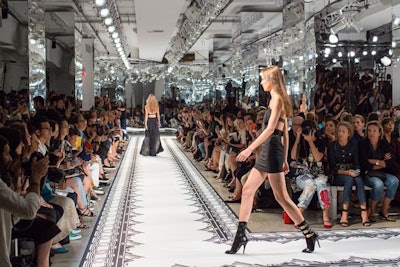
For her latest designer collaboration, Donatella Versace hosted the debut of the Versus Versace by Anthony Vaccarello collection with typical glitz and glamour. The September 7 fashion show at Metropolitan West utilized the venue’s entire 24,000 square feet of space. Produced by KCD, the fashion show on the main level featured a wall-to-wall mirrored space with an art-rendered runway set close to guests.
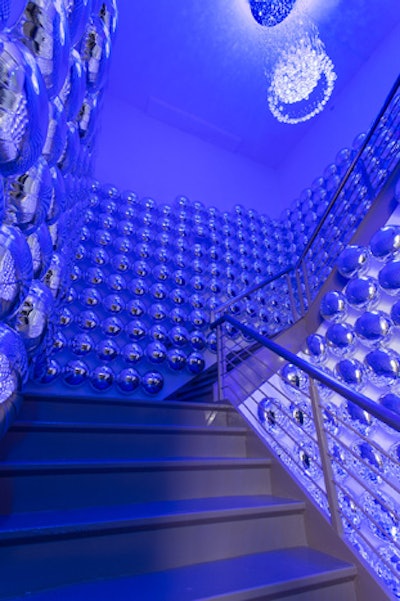
From the show to the after-party, guests at the Versus Versace event ascended a staircase surrounded by hundreds of metallic Mylar balloons strung like one gigantic pillow.

The after-party space featured expansive tiered seating areas in red, cityscape and Versace motifs projected onto the walls, and venue columns wrapped in the fashion house’s iconic motifs.
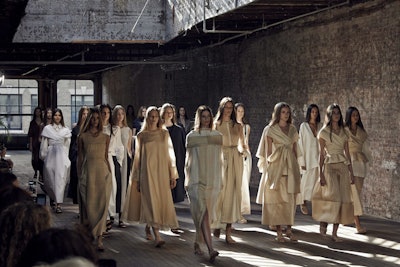
The raw and stripped venue at 52 Mercer Street in SoHo served as the striking backdrop for the Row’s serene and subdued collection on September 8. Guests seated along one long metal bench faced a stark brick wall against which the models walked. Housed on the building’s top fifth floor, the venue also lent the advantage of having natural morning sunlight pour through the skylights, highlighting the fabrics and showcasing details.
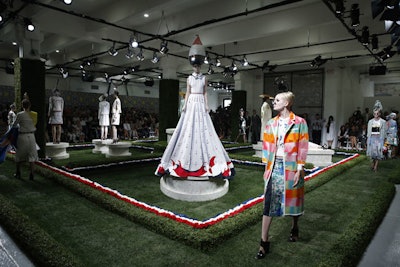
A literal garden wonderland, Thom Browne’s September 8 show at Center548 featured a lush lawn, faux-privet columns, and tricolor bands of flowers lining the square runway. Produced by Villa Eugenie and co-produced by Kaleidoscope Consulting, the show involved arriving guests being met by 10 models posing as living statues on painted pedestals or balanced on stilts in the center of the garden. In lieu of a thumping soundtrack, a bedtime story that Browne wrote for the occasion was soothingly narrated by actress Diane Keaton.

To achieve Carolina Herrera’s vision of a futuristic, sculptural forest for her September 8 show, AO Production manipulated the existing confines of the Lincoln Center tent venue in an abstract manner—raising the theater’s floor and extending it over the first two rows of seats. The existing 15-foot-wide runway was widened to 28 feet to achieve a sense of openness. The loss of 200 seats aside, the forest centerpiece, complete with 20 MDF trees painted dark green, were sized eight, 12, and 16 feet tall. Ninety seats sat in the middle of the runway, with the models crisscrossing throughout. The show marked the first time an all-white set, including a white proscenium and all the risers, was incorporated into Herrera’s show.

Phillip Lim created multiple distinct sections for his September 8 show at Skylight Clarkson Square—with cues taken from his own apartment, currently under construction. With a show inspired by bedroom intimacy, the abstract residential feel had guests seated a good distance from the models’ path, making for an expansive, and undistracted, runway. Palmer Schwartz Agency produced the show.
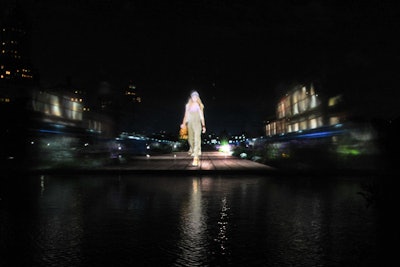
Billed not as a fashion show but, rather, a “fashion event,” Ralph Lauren’s September 8 extravaganza at Cherry Hill in Central Park showcased his Polo women’s collection in four-dimensional form. Produced by Prodject, guests were shuttled from the Central Park West entrance in golf carts, where, during cocktails, they were greeted by a string quartet and served Ralph’s burgers and lobster rolls (catered by Olivier Cheng) from specially built food kiosks. The pricey 4-D cinematic event—part water show, part video—featured models walking through digitally recreated sections of New York, the latter projected against a screen of water shooting up into the air. It all ended with the moon rising to Frank Sinatra’s “Fly Me to the Moon” as Lauren himself—or more precisely, his hydro-holographic image, rose above all and did a little Astaire move, while skimming atop the water.
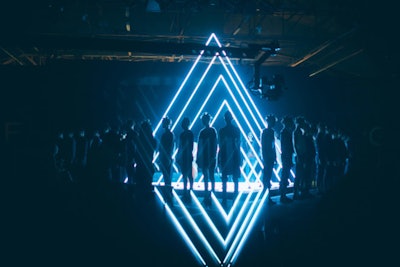
Guests at the Marc by Marc Jacobs show arrived at Pier 94 to what appeared to be a rave temple, with neon lighting streaking across an otherwise all-black venue. The September 9 show, produced by KCD, featured an ear-bleeding drum-and-bass soundtrack blaring from enormous black speakers stacked like altars while a triple-prism of triangular light bars stood at the top of the runway.

Following a six-year hiatus, the televised fashion-music celebration Fashion Rocks returned on September 9, bringing performers like Jennifer Lopez, Kiss, Nicki Minaj, and Pitbull (pictured) to Brooklyn's Barclays Center. And although the two-hour show didn't perform as well as expected—Billboard reported the telecast drew just 2.4 million viewers, less than half the number the event saw at its last iteration in 2008—there was certainly plenty of buzz surrounding Justin Bieber's on-stage appearance. (While being booed, the singer stripped down to his underwear.) Three Lions Entertainment C.E.O. Richard Beckman and Don Mischer of Don Mischer Productions served as executive producers of the show; partners included Calvin Klein, Garnier, LG Electronics, Macy’s, Maybelline New York, and Mazda.
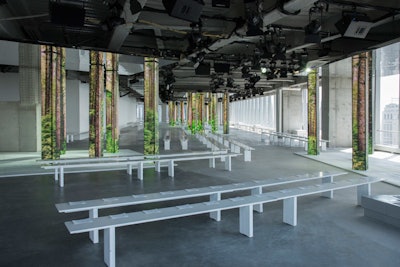
Held on the eve of the anniversary of the September 11 attacks, the 54th floor of 4 World Trade Center in Lower Manhattan served as the ultimate backdrop for the Bureak Betak-produced show. Taking inspiration from “#THISISBOSS,” an art piece that screened during the show created by Hugo Boss creative director Jason Wu and video artist/director Marco Brambilla, the LED panels placed over the columns represented a dialogue between art, technology, and nature—the result of which was a virtual forest flanking the models as they walked down the concrete runway within the unfinished space.
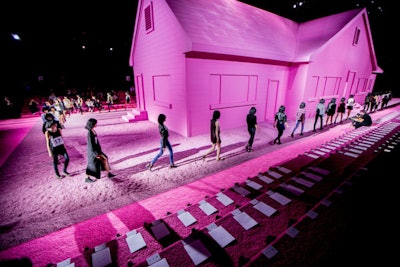
For his first-ever move uptown, Marc Jacobs’s September 11 show at the Park Avenue Armory was, in traditional form, an immersive—and ethereal—experience. Produced by KCD, the show saw set designer Stefan Beckman work with Jacobs on “the idea of a giant house that fell out of the sky.” The proportions were real, albeit slightly exaggerated: a Pepto-Bismol pink 9,000-square-foot house made of wood, luon ,and homasote that contrasted the subdued colors of the clothing on the runway; 15,000 square feet of custom dyed carpet; a runway poured from seven tons of gravel; Beats by Dre headphones at every seat that provided individual show narration; and risers that rose 12 feet high. “You couldn’t see across the runway,” said Beckman. “The idea was to focus on the girl that was walking. We wanted everything really forced together.” Although overall a smoother experience than showing downtown, because the Tommy Hilfiger show took place in the same venue, Beckman’s team had only three days—not the typical week—to load in and build.
















